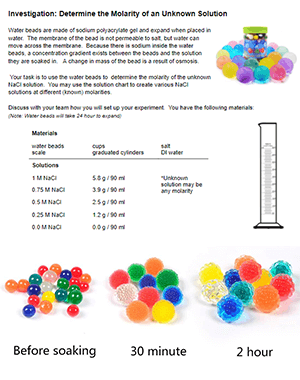
Students studying the cell membrane usually learn about osmosis and diffusion in the same unit. The cell membrane is an amazing structure, semipermeable with surface proteins that perform different functions. Unfortunately, the fluid mosaic model is not always as big of a hit with students as it is for biologists. I struggle with trying to make cell membrane lessons more fun and interactive, so this lesson brings a little bit of joy to the concept of osmosis.
This assignment is a little more advanced than “modeling osmosis” because it includes the concept of molarity. AP Biology students will have already taken chemistry, so they should already have a background. Freshman students can still do this, but you might need to do a quick explanation on what molarity means.
I have two versions of this activity (included in the download). The first is an inquiry based lab where students design their own experiment with minimal instructions from the teacher. The second is version has explicit directions on how to set up the experiment and collect data.
Experiment with Water Beads
The experiment is simple. Students determine the mass of water beads after soaking them in various solutions. They use the change in mass to determine the molarity of an unknown solution. You can make the unknown identical to the known solutions (.25M, .5M, .75M, 1M)
You can also make a it little more challenging by creating a solution that is between those values. A graph can help students determine the unknown, but honestly, they can also just “eyeball” the data and estimate.
My AP Students already do a lab on water potential using dialysis tubes, so I considered making this activity a type of performance assessment for them. The set-up is simple, you just need scales, graduated cylinders, and water beads.
Students can create their own solutions (directions included) or you can reduce the time needed by giving them pre-made solutions. I do not have an answer key for this, but the questions are straightforward, plus data is likely to be variable.

